The Creator & Small Publisher’s Guide to the Diamond Distribution Cycle
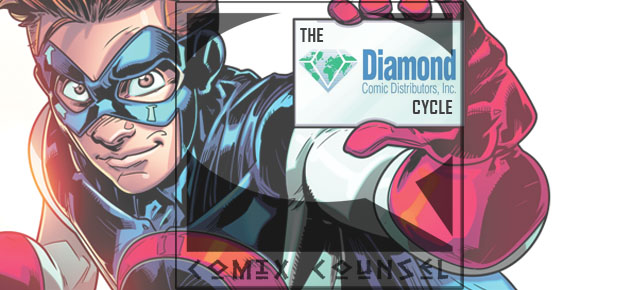
There have never been more ways to distribute your comics and graphic novels. Conventions, direct-to-retailer sales, webcomics, Comixology, Kickstarter, iBooks, Kindle…exploring some (or all) of these options simply makes sense for the savvy creator. Yet, for many, the ultimate goal is to have your books announced, distributed, released, and purchased along side all the other offerings at your local comic shop on a magical new comics Wednesday in the future. And that means distributing your books through Diamond Comics Distributors, Inc.
While most creators are aware of Diamond, I’ve noticed (at least from questions that I get from creators) that there is a fair bit of ignorance about how Diamond distribution works. And while many of you might not intend to ever tackle distributing through Diamond on your own, if you’re pitching your books to small and mid-sized publishers, it’s important that you understand the system. [Note: This article discusses the process AFTER you have landed a Diamond distribution agreement. If you’re looking for more on how to first establish a relationship with Diamond to put your books through the cycle below, read my article Tips for Submitting to Diamond.]
I’ve been through this cycle many times now, with SCAM, THE RED TEN, and THE STANDARD. I’ve made some mistakes (a bunch) and taken some lumps (financial and otherwise) as a result. But that’s where experience comes from, right?
Now, as I prepare to launch EPIC through Diamond, the first new series in the next wave of ComixTribe books, it seems like a good time to explain the cycle. I’m going to walk you through each step of what it takes to put out a new series through Diamond for an independent creator or small publisher.
The Diamond Distribution Cycle – A Six-Month (or More) Process
Step 1 – New Series Submission (Month Zero)
The rules for Marvel, DC, Image, and the other top publishers are different than the ones for publishers ComixTribe’s size. Everything from placement in their Previews catalog, to specifics of their distribution deals, to the length of the order window…it’s all more favorable for the big guys. Make no mistake, the Diamond distribution system is NOT a level playing field. Nor should it be. Those publishers are reliable money makers for Diamond. They keep the company in business, whereas upstarts like ComixTribe represent pocket-change to their bottom line. Not complaining. Just acknowledging.
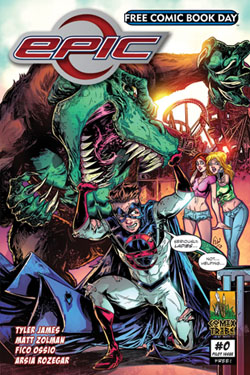
Cover to the EPIC pilot issue. We sent a fully complete issue to our Diamond rep to get series distribution approval.
One example of this is that we need to submit any new series we’d like to publish to our Diamond reps for distribution consideration. No matter how many beers you buy me at a convention (Guiness, please), if my Diamond rep tells me that they can’t sell your book, ComixTribe can’t distribute it through Diamond for you. Sorry.
While no doubt some good books fail to make it through the Diamond screening process, it’s a fair one. The team that reviews new series submitted is composed of former retailers and comic market veterans with their pulse on the market. If they say retailers won’t buy a book, they probably know better than you or I.
Now, I’m certain publishers like Dark Horse or Image don’t need to go through this process. If you get Stephenson’s or Richardson’s stamp of approval, that’s good enough for Diamond. Alas, as publisher of ComixTribe, my stamp doesn’t carry that kind of weight. Instead, I need to essentially pitch Diamond on our new series. That means having a completed book. (Yeah, the whole thing. Five pages and a cover need not apply.) I also need to give them information about the series (limited? ongoing? monthly? bi-monthly?) and any unique selling points or promotional plans that might shed light on its sales prospects. Essentially, before I can sell the book to the readers, or to the retailers, I need to “sell” it to Diamond.
For EPIC, I sent a PDF of the full pilot issue (which you can get for FREE on FREE COMIC BOOK DAY May 3, 2014. Mark your calendars!) to my Diamond rep. Luckily, she was impressed with the issue, and it was accepted without much incident. We the discussion then turned to release schedules, and solicitation dates, which really gets us into the Diamond cycle.
Key Takeaways:
- A small publisher’s “Yes, we’ll publish” does not greenlight Diamond Distribution. Only Diamond does.
- You’ll need to submit the finished product (at least an issue’s worth) before you’ll know if Diamond will distribute your book. So, if you’re pitching small publishers, realize you may have to commit to completing a full issue before they’ll ever give you a definitive yes. It’s not because they’re indecisive, it’s because it may not be their decision.
- You will need to “sell” your book, well before you ever get a chance to sell your book.
Step 2 – The Solicitation (Month 1)
Once your new series has been accepted, the next step is to send in solicitation information. Diamond provides publishers a standard form to fill out. Here’s the solicitation information for EPIC #1:
PRODUCT INFORMATION SHEET
Company Name/Address:
ComixTribe
xxxxxxxxxxxxxxxxxxx
Newburyport MA, 01950
Email Address: xxxxxxxxx@comixtribe.com
Phone: xxx-xxx-xxxx
Product Title: EPIC #1
Issue/Volume Number: 1
Number of Issues/Volumes in Series: Ongoing
Frequency of Publication (Monthly, Bimonthly, Quarterly, etc.): Bimonthly
Intended Audience (All Ages, Mature Themes, Adult): Teen
Genre (Superhero, Sci-Fi, Fantasy, Horror, Western, etc.): Superhero, Comedy
Format (dimensions, pg count, FC/B&W/PC, SC/HC): 32 pg, FC, foil-stamped embossed cover
Retail Price: 3.99
Diamond Discount: 60% off
Printer: Trivision
Country of Printing: Korea
Ship Date/Month: May (Note: May arrive in April. Want to hold to release May 7, the Wednesday after the Free Comic Book Day debut of EPIC #0.)
UPC Code: 610395132615 00111
(NOTE: including a UPC and/or ISBN number at the time of solicitation is mandatory)
Author(s): Tyler James
Artist(s): Fico Ossio
Cover Artist(s): Fico Ossio
Synopsis: Miami’s newest teenage superhero has a weakness for beautiful girls literally! Hot on the heels of its world-wide FREE COMIC BOOK DAY debut, your new favorite superhero action comedy begins its EPIC ongoing series run! Witness the frightening origin of EPIC’s first fearsome foe, the half-man/half-spider monstrosity DADDY LONG LEGS! See the scintillating first appearance of SCAREWOLF! Watch our hero whiff at his first attempt to woo the pretty new girl at school! All that and a FOIL-EMBOSSED COVER, brought to you by writer Tyler James (The Red Ten) and rising-star artist Fico Ossio (Critter)!
At this time, you also submit a cover your book. While some publishers will send cover art labeled “NOT FINAL COVER”, that’s generally frowned upon for us indies, and is probably a strike against us, sales wise.
Now, most of the details in that form are pretty standard, and worked out ahead of time. For example, all ComixTribe titles are sold to Diamond at 60% off the cover price. (Yup, if a reader drops $3.99 on a top-quality CT funnybook, $1.59 finds its way to us, about $1.99 goes to your retailer, and Diamond keeps the rest.) We use Trivision to print most of our floppies, and for more on UPC Codes, check out this pulse-pounding ComixTribe article.
This submission will get you a 3-inch listing in their monthly PREVIEWS catalog. It’ll be in the back, in alphabetical order with the rest of the small press publishers, and look something like this one from the APRIL 2013 PREVIEWS that had two ComixTribe books listed.
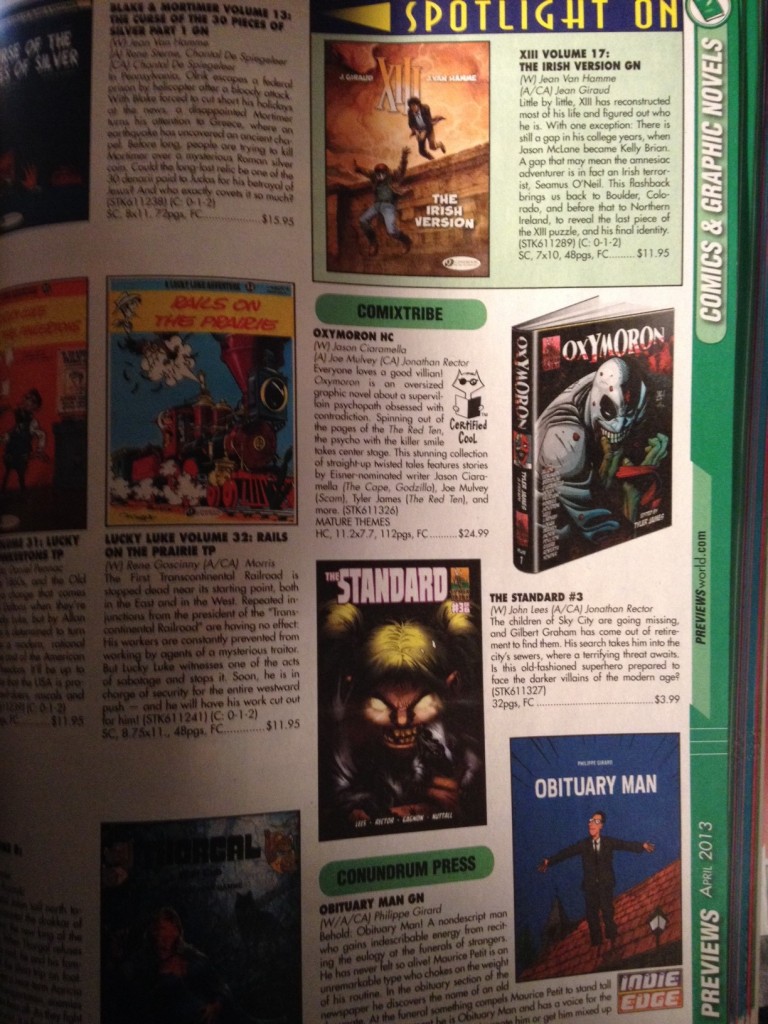
Yes, it’s as small as it looks. Publisher’s can also choose to buy bigger advertising space in the same PREVIEWS catalog near their listing. I’m not sure if the advertising rates are public knowledge, but let’s just say, a full-color add in the back of Previews will cost you probably as much as it cost to make your book…if not more!
As a boot-strapped small publisher, ComixTribe has yet to indulge in print advertising within the PREVIEWS catalog, so I can’t speak with authority on the impact that has.
Solicitation information is usually due around the 10th of the month, two months before the issue of PREVIEWS will be released, and four months before the issue generally hits the shelves on a Wednesday. I solicited the information for EPIC #1 on December 10, so that it will be in the February Previews, for a May 7, 2014 street date.
Key Takeaways
- You need a blurb, cover, UPC code (for comics) or ISBN number (for trades), and a printer in place to solicit a book with Diamond.
- You need to solicit a book a bare minimum of four months before you can expect it to hit the shelves.
- 40% of the cover price is what publishers will generally receive from Diamond.
Dead Time (Month 2)
From the Diamond cycle perspective, there really isn’t much to do the month after your book is solicited. It’s pretty much just kicking back on a hammock, sipping cool lemonade, while…

…Or more likely you’re hard at work actually making the comics you’ve already committed to soliciting. There’s always that.
STEP 3 – Your Comic is in PREVIEWS (Month 3)
On January 29, 2013, all 400+ pages of the FEBRUARY 2014 issue of PREVIEWS will go on sale in comic shops across the country. (Retailers, will get their hands on that monstrosity a few days earlier.) Somewhere, buried in the back will be the cover and my solicitation text for EPIC #1.
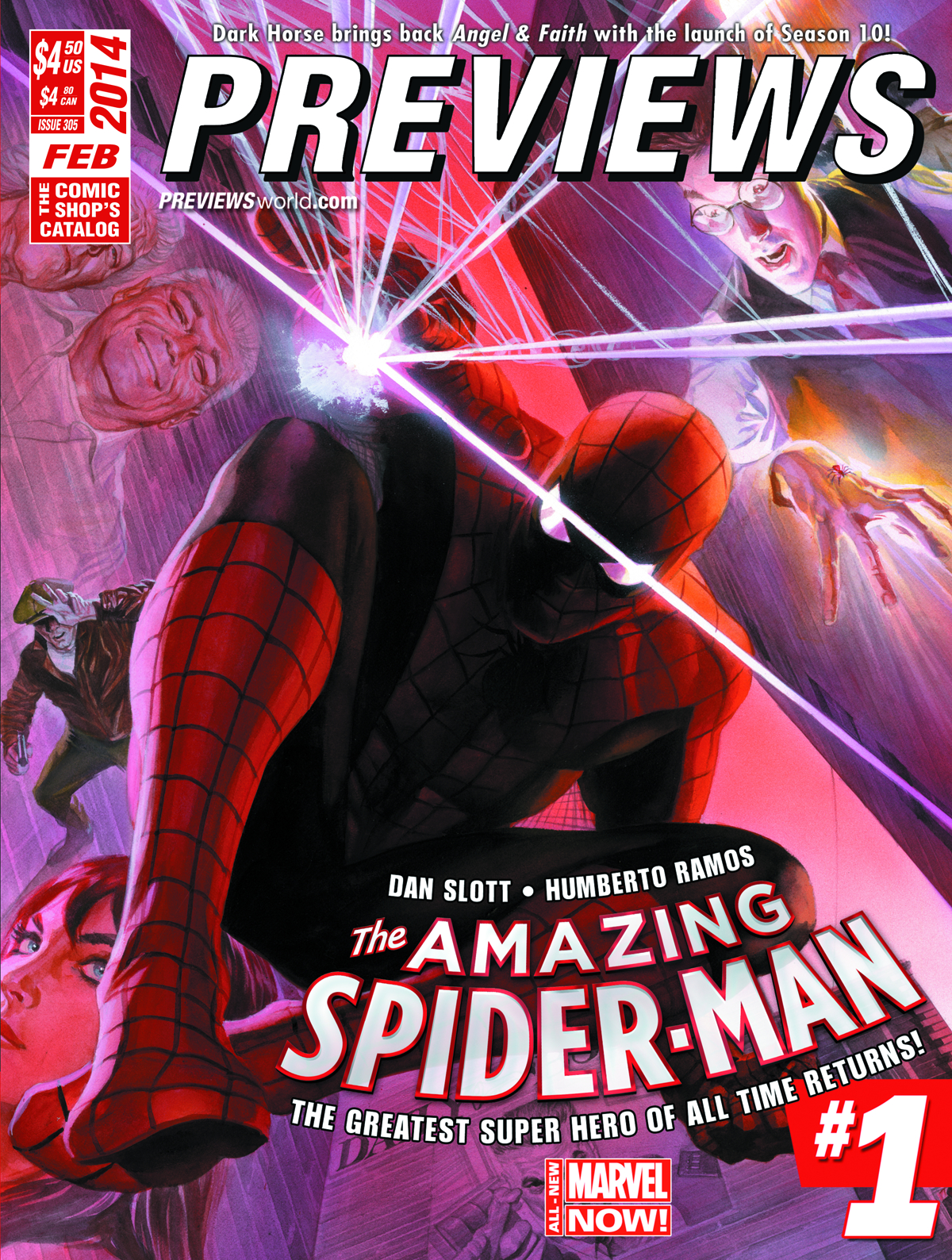
Somewhere, buried in the depths of this catalog, you can find a solicitation for EPIC #1.
For the next 30 days or so, retailers will have the difficult task of deciding how many copies of this indie gem to order. Interested readers can pre-order the book using Diamond Code EPIC #1 (FEB141121 ) or add it to their pull-list, which lets retailers know there is at least some interest in the title.
In many ways, this is the most important month in the entire Diamond cycle. This is the time when publishers need to make retailers aware of their new series, and encourage readers to pre-order it during the 30-day window. It’s also the most stressful time for publishers, and I’ll admit, I certainly don’t have this step of the cycle down to a science. But the main goal of this month is to convince as many retailers as possible to order as many copies as possible of your new series. With rare exceptions, issue #1 sales will be the highest your series will ever attain. So you need to get out of the gate with as high numbers as possible.
Aside: With EPIC‘s launch, I’m trying something new, and strategic. EPIC #1 won’t actually be the first issue of EPIC distributed by Diamond. Back in October of last year, I submitted the EPIC pilot issue for Free Comic Book Day consideration, and it was accepted. So, now, retailers are deciding how many copies of EPIC #0 Pilot to order, which they will give away for free on May 3, for the FREE COMIC BOOK DAY event. Last year, ComixTribe’s first participating in the FCBD event, retailers ordered more than 31,000 copies of THE RED TEN #0. To put that in perspective, that’s more than ten times the orders on any one of our regular titles.
My gambit here is that retailers will order EPIC #0 Pilot in similar numbers in January. Then, they’ll get the February PREVIEWS, see that EPIC #1 comes out the very next Wednesday after FREE COMIC BOOK DAY, and order it more than they would any old back-of-the-catalog new series number one. That’s the plan, anyway. (Wood, I’m knocking on it.)
But, back to PREVIEWS month. While orders are open, I’ll likely also:
– Send out a few Press Releases previewing EPIC #1, both to retailers and comics media.
– Send full PDF review copies to my retailer list, promoting EPIC #1.
– Call as many shops as I can, encouraging them to order it.
– Reach out to retailer networks (such as the Phantom Variant program) and try to get them on board for a variant cover.
– Line up store signings to promote the launch of the new series (stores that are going to have signings will tend to order more books.)
All of this work will ultimately boil down to one number…which we’ll get the next month.
Key Takeaways
- Books are solicited in Previews two months (or more) before they release in shops.
- There is about a 30-day pre-order window, where Diamond is taking orders for your books from retailers.
Step 4 – The Diamond Purchase Order & Setting the Print Run (Month 4)
After collecting pre-orders from their 4,000 or so retail accounts, Diamond will tally up all the pre-orders for your book, determine what, if any overstock position they may want to take in it, and generate an order number. This is the total number of books Diamond will purchase from you, at 60%-off cover price.
Rarely have I received a purchase order from Diamond and been pleased. My reaction generally rages from, “Oh my God, that’s it?” to “Well, it’s about what I expected.” Comics is a tough business, and it’s probably toughest on retailers, who purchase most of their product on a non-returnable basis. If the book doesn’t sell, it’s money flushed down the toilet for the comic shop. But the most frustrating part for me is seeing that an abysmally low % of retailers order even a single copy of our books. I think we’re putting out good product that is only getting better, but independent, small-press titles are a gamble for retailers.
But, regardless of whether your order numbers are low, horribly low, or put a gun to your head and pull the trigger low, at this point you have an important decision to make:
How many copies are you going to print?
Easy. Just print the number on the Diamond purchase order, right?
Yeah, I guess it would be, if your only distribution channel was through Diamond. However, small-publishers like ComixTribe do a robust business in convention sales, and sell hundreds of books a year through our online website shop.comxtribe.com. So, we’re always going to set our print runs higher than our purchase order number, and take advantages of the economies of scale. (The more you print, the cheaper each unit costs.)
But how much higher should your print runs be? Yeah, that’s always the tough question. A publisher can lose a lot of money getting that answer wrong. See, what distributing through Diamond does is allow you to do a big off-set print run. Even if you’re only getting orders from Diamond for 800 copies, the cost of printing 1000 books is nearly the same as printing 800. Essentially, Diamond sales subsidizes your print run, and while you might not make much profit selling through Diamond, once you sell off those extra books at cons or online at full cover price, you’ll start to see a small return.
But if you order too few books, as we did with both SCAM #1 and THE STANDARD #1, which are now completely sold out, it’ll cost you a lot of money to go back to press. (Or lost sales for not having those books in stock.) Diamond actually sold completely out of their overstock of both those titles, and put in a re-order for more copies of each. For SCAM #1, unfortunately, we didn’t have those copies to give them, and lost out on a few hundred dollars in extra sales. (It wouldn’t have been worth it to print just a few hundred more copies, to sell at 60% off.) We were able to fulfill a large reorder for THE STANDARD #1, having learned our lesson from SCAM, but have gone on to sell out of that book at shows.
On the other hand, if you order too many books that will never sell, then you have to deal with the cost of both printing them (that money could have been profit) and storing them as inventory.
One thing that I’ve found, though, is you really can’t go wrong ordering big on issue #1. First issues will always sell. For example, at cons and online, we sold more issues of THE RED TEN #1 in 2012 than in 2011, and more in 2013 than in 2012. So, you can bet we’ll be doing a significant over-print of EPIC #1.
Regardless of the alchemy you use to come up with a print run number, it’s up to YOU to contact your printer, get them the files for the book, and forward them Diamond shipping details. No, Diamond does not handle printing they only distribute product that is sent to them.
CASH FLOW ALERT! In most cases, this is the month you also have to pay your printer to print those copies. And yes, you have to use your own (or someone you know with deep pockets’) funds for that. Diamond does not pay you in advance for your books.
Key Takeaways
- Diamond will tell you exactly how many books they want, exactly how much they’ll pay you for them, and exactly where to ship them.
- You need to tell your printer how many books to print, a number generated by considering the Diamond purchase order size and how many copies you want for yourself.
- Two months before the books hit the shelves is usually when you have to pay for them.
Step 5 – The Printer Ships to Diamond (Month 5)
At this point, most of the work is out of your hands. It’s up to the printer to print your books and ship them to Diamond per their instructions. Most printers print lots of comics for many publishers each month, and ship palettes to Diamond at a time, meaning they usually bake their shipping costs into the quote. However, they will probably charge you for extra publisher stock shipped directly to you.
Where you’re printing will determine how fast books get to Diamond. Transcontinental, a large printer in Canada who will be handing the EPIC #0 Free Comic Book Day, can get books printed and shipped to Diamond in just a couple of weeks. Trivision, the Korean printer we’ll likely use for EPIC #1, takes 5-6 weeks to print and ship books from overseas.
CASH FLOW ALERT! Upon confirmation of Diamond’s receipt of your books from the printer, you may send them an invoice for those books. Note, if you don’t send them an invoice, they won’t send you a check until you do. (Another gem I learned the hard way.)
Key Takeaways
- Printers will handle the legwork of printing and shipping your books to Diamond. But you need to stay on top of them to make sure they deliver.
- Send an invoice as soon as your books arrive to Diamond. They pay 30 days later.
Step 6 – Your Book Hits the Shelves & You Get a Check (Month 5)
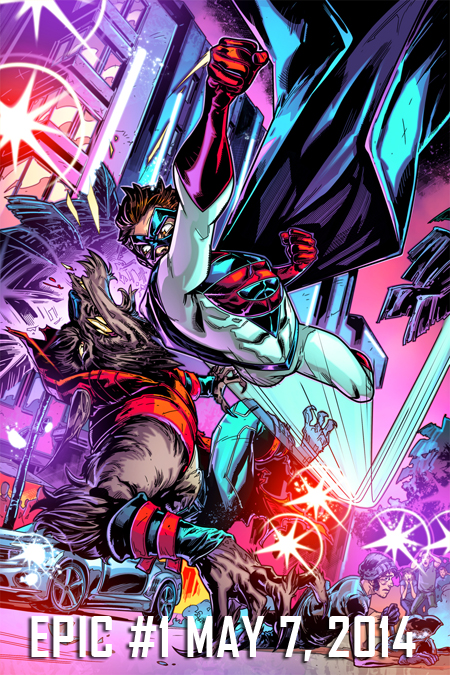 The first Wednesday two weeks after Diamond receives your books from the printer is when your comic is likely to release at local comic shop. Often, people will ask earlier in the process when a book will come out, and I’ll tell them that I can’t give them a specific date. That’s because it all depends on when the book arrives and is processed in the Diamond warehouses.
The first Wednesday two weeks after Diamond receives your books from the printer is when your comic is likely to release at local comic shop. Often, people will ask earlier in the process when a book will come out, and I’ll tell them that I can’t give them a specific date. That’s because it all depends on when the book arrives and is processed in the Diamond warehouses.
So, how am I advertising EPIC #1 as releasing on May 7? Well, again this is a strategic move. I want readers to pick up the FCBD issue on May 3, love it, and then come right back the next Wednesday to grab #1.
Technically, books solicited in the February previews, like EPIC #1, start going on sale in April. I’m working with my Diamond rep to make sure that book is held for a May 7 street date, to take advantage of the FCBD bump. Of course, this means I need to get the finished files to my printer on time, and they need to deliver it as well. So, there is some risk in the move. But as I intend to have the book finished and to my printer before I even get a purchase order for it, I’ll be mitigating that risk as best as I can.
CASH FLOW ALERT! And then, 30 days (or a few more I’ve found) after Diamond receives an invoice, you’ll receive a check in the mail. Hooray! Of course, if your book is a bi-monthly series like EPIC, you’ll likely be forwarding that check directly to your printer, who’s already working on the next issue.
And the cycle begins again…
Key Takeaways
- Exact street dates for books are hard to get in advance. Diamond usually gets them on the shelves two weeks after they receive and check in your books.
So, that’s the Diamond Cycle
As you can tell from this wordy, but hopefully informative overview, such a cycle requires careful planning, timing, and cash-flow management, as it can be 60 days or more from when you need to pay your printer to when you can expect to receive money from Diamond. Doing this for a single series is a lot of work. Juggling multiple series, on different production schedules…yeah, it’s a challenge.
And What Happens if Something Goes Wrong?
It’s simple: It costs you money.
- Send a book to Diamond with an unreadable barcode? $150 fee. (Yup, did that.)
- Printer sends your books in a box that’s labeled improperly. $150 fee. (That happened.)
- Fail to send a book you received a purchase order for within a 30 days of the solicited release month? That order can be canceled, the book will be re-solicited, retailers can revise down their orders. And a fee. (Ashamed to say, that also happened.)
Comics is business. Playing in the big leagues, requires as much managerial acumen as creative.
WHAT DID I LEAVE OUT?
Hopefully, you have a better idea of the Diamond cycle now. But if there are more questions, or things I didn’t include that I should have, I want to hear them. I’m opening the comments section below for you to ask any more questions about the cycle, or tell me what I missed.
And for further discussion, head over to the ComixTribe forum on Digital Webbing.
Keep Reading!
If you found this article useful, you may want to read one of these three articles next:
Tips for Submitting to Diamond
Hard Numbers, Hard Lessons
Everything You Need to Know About Small Press Distribution
Related Posts:
Category: Comix Counsel

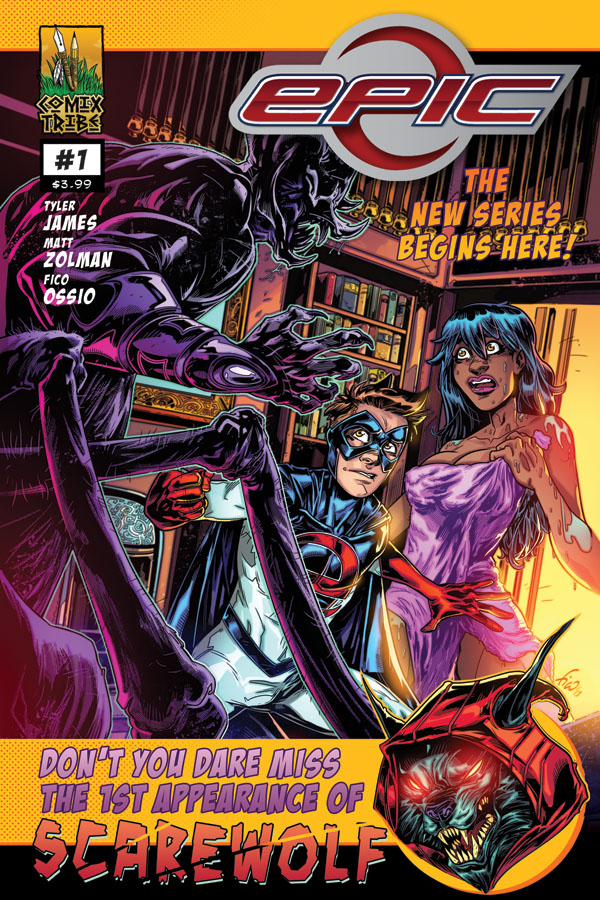
















Man… I hate all these details so much. I hate them because they are so far from actually making comics.
So, sincere thanks for learning all of these lessons the hard way so that I might not have to.
Glad the article was helpful, Josh.
I know the feeling…there’s so much to the comics business that has ABSOLUTELY NOTHING to do with being creative.
I come from the corporate business world, so I totally get this and feel quite prepared for the non-creative stuff, particularly the margin squeeze that Diamond and retailers will put on you. Luckily I’m in it for the love of the game, and not the cash. Good stuff.
@theCruZader
This was incredibly insightful. I’ve been doing quite a bit about Diamond, but your article would have saved me so much time. Great job and thank you for sharing with us newcomers to the market.
Outstanding info in general. As an independent write, I aim to self publish some of my stuff. I am also submitting to some bigger companies as well. Mainly so they’ll handle all of this stuff. Thanks again
Hi Tyler quick question.
What names go on the invoice? The printing company and diamond or the publisher and diamond
YOU are sending the invoice and Diamond is paying YOU.
YOU pay the printer, usually 2-4 months before you’ll ever see a check from Diamond. (Another reason why the Diamond model is difficult on small pubs… cashflow is king, and you’ll need to put a lot out before you’ll ever see any back.)
There really needs to be a serious alternative to Diamond. Don’t get me wrong, they got where they are by being the smartest kid in the class. That doesn’t mean I have to like it. This was a great insight and shows why the only comics that the publishers I have worked for ever sold were the ones they took to comicons. Thank you for putting this out there.
Great article! But I have some questions. Do I have to pay Dimond to get the comics published? And what are some good companies or people that could do the printing? Please let me know when you can.
Great article! But I have some questions. Do you have to pay to publish your comic on diamond? What is the best company or person to do the printing for the comic?
You do not pay Diamond. They pay you! They buy your books, usually at 60% off the cover price. But you will print them yourself, in advance, and before you are paid. (Diamond pays roughly 30 days after they receive books from you.) There are lots of great printers out there. Three we work with often are 1) Comic Impressions 2) Printlore 3) Trivision.
However, Diamond isn’t the place we recommend creators start… we recommend you look at Kickstarter as the first channel to launch and sell your books through. See the ComixLaunch.com podcast for more on how to prep for success on Kickstarter and beyond.